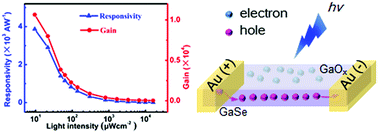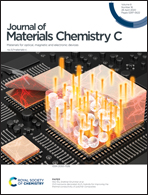Controlled synthesis of GaSe microbelts for high-gain photodetectors induced by the electron trapping effect†
Abstract
GaSe microbelts were successfully synthesized using Ga/Ga2Se3 as the precursor mixture, where excess Ga was required to serve as the metal catalyst. Meanwhile, a spontaneously oxidized surface amorphous oxide (GaOx) layer formed, which induced a built-in electric field perpendicular to the surface. Benefiting from this effect, a GaSe microbelt-based photodetector attained a high responsivity of ∼3866 A W−1 and a photoconductive gain of up to ∼1.06 × 104. This study sheds light on the controlled synthesis of microstructures and provides a device design concept for high-performance micro/nano optoelectronics.



 Please wait while we load your content...
Please wait while we load your content...